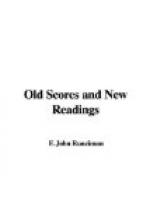For we must not forget that the whole problem for the seventeenth century was one of technique. The difficulty was to spin a tone-web which should be at once beautiful, expressive, and modern—modern above all things, in some sort of touch with the common feeling of the time. I have told how the earlier composers spun their web, and how Lawes attained to loveliness of a special kind by pure declamation. In later times there was an immense common fund of common phrases, any one of which only needed modification by a composer to enable him to express anything he pleased. But Purcell came betwixt the old time and the new, and had to build up a technique which was not wholly his own, by following with swift steps and indefatigable energy on lines indicated even while Lawes was alive. Those lines were, of course, in the direction of word-painting, and I must admit that the first word-painting seems very silly to nineteenth century ears and eyes—eyes not less than ears. To the work of the early men Purcell’s stands in just the same relation as Bach’s declamation stands to Lawes’. Lawes declaims with a single eye on making clear the points of the poem: the voice rises or falls, lingers on a note or hastens away, to that one end. Bach also declaims—indeed his music is entirely based on declamation,—but as one who wishes to communicate an emotion and regards the attainment of beauty as being quite as important as expression. With him the voice rises or falls as a man’s voice does when he experiences keen sensation; but the wavy line of the melody as it goes along and up and down the stave is treated conventionally and changed into a lovely pattern for the ear’s delight; and as there can be no regular pattern without regular rhythm, rhythm is a vital element in Bach’s music. So with Purcell, with a difference. The early “imitative” men had sought chiefly for dainty conceits. Pepys was the noted composer of “Beauty, Retire” and his joy when he went to church, “where fine music on the word trumpet” will be remembered. He doubtless liked the clatter of it, and liked the clatter the more for occurring on that word, and probably he was not very curious as to whether it was really beautiful or not. But Purcell could not write an unlovely thing. His music on the word trumpet would be beautiful (it is in “Bonduca"); and if (as he did) he sent the bass plunging headlong from the top to the bottom of a scale to illustrate “they that go down to the sea in ships,” that headlong plunge would be beautiful too—so beautiful as to be heard with as great pleasure by those who know what the words are about as by those who don’t. Like Bach, Purcell depended much on rhythm for the effect of his pattern; unlike Bach, his patterns have a strangely picturesque quality; through the ear they suggest the forms of leaf and blossom, the trailing tendril,—suggest them only, and dimly, vaguely,—yet, one feels, with exquisite fidelity. Thus Purcell, following those who, in sending the voice part along




